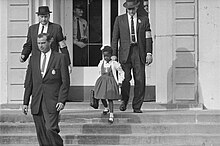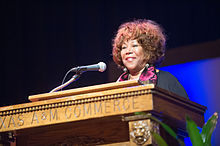Block 6 - Ruby Bridges
Information taken from Wikipedia states:
Ruby Nell Bridges Hall (born September 8, 1954) is an American civil rights activist. She was the first African American child to attend formerly whites-only William Franz Elementary school in Louisiana during the New Orleans school desegregation crisis on November 14, 1960. She is the subject of a 1964 painting, The Problem We All Live With, by Norman Rockwell.
Bridges was the eldest of five children born to Abon and Lucille Bridges. As a child, she spent much time taking care of her younger siblings, though she also enjoyed playing jump rope and softball and climbing trees. When she was four years old, the family relocated from Tylertown, Mississippi, where Bridges was born, to New Orleans, Louisiana. In 1960, when she was six years old, her parents responded to a request from the NAACP and volunteered her to participate in the integration of the New Orleans school system, even though her father was hesitant.
Background
Bridges was born during the middle of the Civil Rights Movement. Brown v. Board of Education was decided three months and twenty-two days before Bridges' birth. The court ruling declared that the establishment of separate public schools for white children, which black children were barred from attending, was unconstitutional; accordingly, black students were permitted to attend such schools. Though the Brown v. Board of Education decision was finalized in 1954, southern states were extremely resistant to the decision that they must integrate within six years. Many white people did not want schools to be integrated and, though it was a federal ruling, state governments were not doing their part in enforcing the new laws. Under significant pressure from the federal government, the Orleans Parish School Board administered an entrance exam to students at Bridges' school with the intention of keeping black children out of white schools.
Integration
Bridges attended a segregated kindergarten in 1959. In early 1960, Bridges was one of six black children in New Orleans to pass the test that determined whether they could go to the all-white William Frantz Elementary School. Two of the six decided to stay at their old school, Bridges went to Frantz by herself, and three children were transferred to McDonogh No. 19 and became known as the McDonough Three. Bridges and her mother were escorted to school by four federal marshals during the first day that Bridges attended William Frantz Elementary. In the following days of that year, federal marshals continued to escort Bridges, though her mother stayed behind to take care of her younger siblings.
Bridges' father was initially reluctant, but her mother felt strongly that the move was needed not only to give her own daughter a better education, but to "take this step forward ... for all African-American children". Her mother finally convinced her father to let her go to the school.
Judge Skelly Wright's court order for the first day of integrated schools in New Orleans on Monday, November 14, 1960, was commemorated by Norman Rockwell in the painting, The Problem We All Live With (published in Look magazine on January 14, 1964). As Bridges describes it, "Driving up I could see the crowd, but living in New Orleans, I actually thought it was Mardi Gras. There was a large crowd of people outside of the school. They were throwing things and shouting, and that sort of goes on in New Orleans at Mardi Gras. Former United States Deputy Marshal Charles Burks later recalled, "She showed a lot of courage. She never cried. She didn't whimper. She just marched along like a little soldier, and we're all very very proud of her."

As soon as Bridges entered the school, white parents pulled their own children out; all the teachers except for one refused to teach while a black child was enrolled. Only one person agreed to teach Bridges, and that was Barbara Henry, from Boston, Massachusetts, and for over a year Henry taught her alone, "as if she were teaching a whole class."
That first day, Bridges and her mother spent the entire day in the principal's office; the chaos of the school prevented their moving to the classroom until the second day. On the second day, however, a white student broke the boycott and entered the school when a 34-year-old Methodist minister, Lloyd Anderson Foreman, walked his five-year-old daughter Pam through the angry mob, saying, "I simply want the privilege of taking my child to school…" A few days later, other white parents began bringing their children, and the protests began to subside. Yet, still, Bridges remained the only child in her class, as she would until the following year. Every morning, as Bridges walked to school, one woman would threaten to poison her, while another held up a black baby doll in a coffin. This led the U.S. Marshals dispatched to oversee her safety to only allow Bridges to eat the food that she brought from home, and she was not allowed to participate in recess.
The Bridges family suffered for their decision to send her to William Frantz Elementary: her father lost his job as a gas station attendant; the grocery store the family shopped at would no longer let them shop there; her grandparents, who were sharecroppers in Mississippi, were turned off their land; and Abon and Lucille Bridges separated. Bridges has noted that many others in the community, both black and white, showed support in a variety of ways. Some white families continued to send their children to Frantz despite the protests, a neighbor provided her father with a new job, and local people babysat, watched the house as protectors, and walked behind the federal marshals' car on the trips to school. It was not until Bridges was an adult that she learned that the immaculate clothing she wore to school in those first weeks at Frantz was sent to her family by a relative of Coles. Bridges says her family could never have afforded the dresses, socks, and shoes that are documented in photographs of her escort by U.S. Marshals to and from the school.
Adult life

As of 2004, Bridges, now Ruby Bridges Hall, still lives in New Orleans with her husband, Malcolm Hall, and their four sons. After graduating from a desegregated high school, she worked as a travel agent for 15 years and later became a full-time parent. She is now chair of the Ruby Bridges Foundation, which she formed in 1999 to promote "the values of tolerance, respect, and appreciation of all differences". Describing the mission of the group, she says, "racism is a grown-up disease and we must stop using our children to spread it."
In November 2007, the Children's Museum of Indianapolis unveiled a new permanent exhibit documenting her life, along with the lives of Anne Frank and Ryan White. The exhibit, called "The Power of Children: Making a Difference", cost $6 million to install and includes an authentic re-creation of Bridges' first grade classroom.

On July 15, 2011, Bridges met with President Barack Obama at the White House, and while viewing the Norman Rockwell painting of her on display he told her, "I think it's fair to say that if it hadn't been for you guys, I might not be here and we wouldn't be looking at this together".[26] The Rockwell painting was displayed in the West Wing of the White House, just outside the Oval Office, from June through October 2011.[27]
Place a pink 2 1/2 inch square on a corner of a 4 1/2 inch background square. Sew on the line. Trim 1/4 inch from the sewn line. Press. Repeat on one corner of the three remaining 4 1/2 inch background squares.






No comments:
Post a Comment